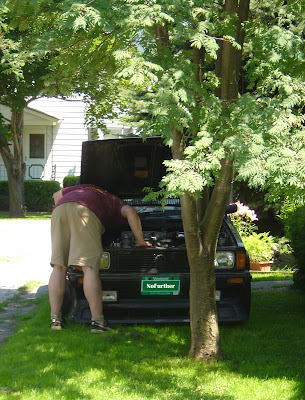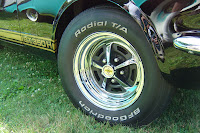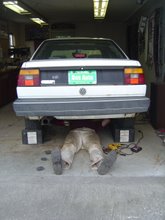
Sunday, July 29, 2007
Saturday, July 21, 2007
Waterfest!!!

There is no disputing the magnitude of the summer’s premier water-cooled Volkswagen/Audi event known to the faithful as Waterfest. The event, held annually in July at Raceway Park in
Englishtown, NJ, is much more than a car show. It is an institution, a sort of subset in the “drivers wanted” sub-culture that is founded on notions such as public intoxication, stretched tires, turbo-power and BBS rims. It is an institution with a host of devotees that are no less fervent than English soccer fans. So infamous for debauchery is the reputation of this show and its partakers that the local police ratchet up their patrols and area hotels require all guests to sign damage and noise waivers.
What happens at Raceway Park is only part of the action. During the show weekend, long caravans of VWs and Audis can be seen weaving their way toward New Jersey from such far off locals as Ontario and Florida. These caravans, called cruises by those partaking, are not unlike long-range tailgate parties, and are often organized by various VW/Audi clubs or aftermarket-tuners. And, though toned down in recent years due to an increased police presence, spontaneous hotel and parking-lot parties always offer circus-like shenanigans that often border on criminal mischief.
With this much energy and enthusiasm involved, it is hard to imagine that any true VW or Audi enthusiast would choose to miss out on Waterfest. However, in protest against how established and commercial it has all become, many enthusiasts elect to stay home to participate in local, anti-fest events in much the same way that nerdy kids go to anti-proms because they can’t get a date. Of course, this only validates the significance of Waterfest in the world of Volkswagen-enthusiasts.
Last year, Waterfest--which features events such as drag racing, auto-cross racing, burn-out competitions, concours, a swap meet and much more--drew in more than 20,000 spectators and 2500 registered participants. No surprise, this year there were more cars, more vendors and more VW nuts running around than ever before. It seems that each year the cars get faster, the crowds get larger and the spectacle of it all becomes more intoxicating. And now, for the photo gallery. First, I have to apologize. I am an oldschool VW fan and the majority of my pictures will reflect this. If you can't stand the sight of Mark I and Mark II VWs, better steer clear.





Friday, July 20, 2007
Wednesday, July 18, 2007
White Jetta Blues


Update: Well, I found the cause of the manifold leak. Yup, lost two exhaust studs somewhere on the road. Ha, some yuppy in a Cayman is probably getting them pulled out of his right-front Pirelli right now. Anyway, after some serious wrenching and a new set of gaskets, I've got it all back together and running smooth.
Wednesday, July 11, 2007
Of course, as a car nut, I spend my time off tinkering in the garage or traveling hundreds of miles to far-flung car shows. This last weekend I went to the New England Summer Nationals in Worcester, Ma – that’s pronounced Wista or Wooster depending on your geographic orientation. The Summer Nationals is tradition for me and I look forward to this annual Muscle car exposition with the same sort of zeal that my daughter chases the ice cream truck. With more than 6000 classic cars, drag racing, burn-out competitions, vendors, swap meet and a bikini contest there is certainly a lot to see and do. And the people at this show-both vendors and car owners-are fantastic. I spent nearly an hour talking to one guy about his ’86 Monte Carlo. I had never met this guy before but he was willing to bare his soul and tell me everything, even about the rust on his car’s frame. That’s a pretty deep and tender subject for most hotroders.
What makes this annual show really fantastic is the variety. Sure, the staples of the classic car culture are represented in great number. There are gads of Camaros, Mustangs and the like. But, every year, I am surprised by the number of off beat cars that make an appearance. These are the cars that command a niche following at best.
 The Dodge Omni, with its boxy and upright lines, is a seemingly unlikely canvas for hotrodding. However, in 1984, the Dodge Omni GLH hit the streets as Mopar's answer to the hotrodded Volkswagen GTi hatchback. And, with a carburated 2.2L in-line four that produced 110hp, the light-weight Omni was right on track with the souped-up Rabbit. The "GLH" moniker is rumored to have been the invention of Carol Shelby himself. The story is that Shelby suggested the car be called the GLH because it "goes like hell."
The Dodge Omni, with its boxy and upright lines, is a seemingly unlikely canvas for hotrodding. However, in 1984, the Dodge Omni GLH hit the streets as Mopar's answer to the hotrodded Volkswagen GTi hatchback. And, with a carburated 2.2L in-line four that produced 110hp, the light-weight Omni was right on track with the souped-up Rabbit. The "GLH" moniker is rumored to have been the invention of Carol Shelby himself. The story is that Shelby suggested the car be called the GLH because it "goes like hell." To add to this "no nonsense attitude" the GLH came fitted with side skirts, a louvered hood and 15 inch aluminum alloy wheels. This was pretty heady stuff for 1984 but the best was yet to come. For 1985, the Omni GLH was made available with a 146 hp turbo-charged four-cylinder. The svelte Omni GLH, weighing in at 2400 pounds, was capable of besting contemporary Mustangs and Camaros. The madness, however, didn't end there. Carol Shelby, of Mustang fame, took into custody 500 turbo Omnis. A Shelby Omni, known as the Omni GLHS, came with a stiffer suspension that included Koni shocks and an intercooler to help handle the temperatures associated with running 12 pounds of boost. The Omni GLHS was capable of covering the quarter mile in less than 15 seconds. In those days that was fast enough to stomp a stock Corvette.
To add to this "no nonsense attitude" the GLH came fitted with side skirts, a louvered hood and 15 inch aluminum alloy wheels. This was pretty heady stuff for 1984 but the best was yet to come. For 1985, the Omni GLH was made available with a 146 hp turbo-charged four-cylinder. The svelte Omni GLH, weighing in at 2400 pounds, was capable of besting contemporary Mustangs and Camaros. The madness, however, didn't end there. Carol Shelby, of Mustang fame, took into custody 500 turbo Omnis. A Shelby Omni, known as the Omni GLHS, came with a stiffer suspension that included Koni shocks and an intercooler to help handle the temperatures associated with running 12 pounds of boost. The Omni GLHS was capable of covering the quarter mile in less than 15 seconds. In those days that was fast enough to stomp a stock Corvette.The 85 Omni GLHS pictured here is number 127 of 500. Note the dash plaque signed by Carol Shelby that shows this number. Also, note the decal added to the speedometer by a previous owner that enumerates speeds above 85mph. This is an interesting artifact of the gas-crunch, a time when we all were suppose to drive slower and never, at any cost,
 exceed 55mph.
exceed 55mph.

Now, like I said before, there was an abundance of classic muscle cars, a cornucopia of Detroit iron, if you will. I do not have the bandwidth to put up a picture of every cherry Mustang or Malibu. So, I will hit upon a few of the outstanding examples.
 First, take a gander at this restored '66 H
First, take a gander at this restored '66 H ertz Mustang. The Hertz rent-a-racer program created a stir back in the '60s when the company ordered 1000 Shelby GT-350 Mustangs for their rental fleet. The Shelby GT-350 was powered by the same 300hp, 289 cubic-inch V8 that Carol Shelby used in the famed Cobra. Tales abound of customers winning races and car shows
ertz Mustang. The Hertz rent-a-racer program created a stir back in the '60s when the company ordered 1000 Shelby GT-350 Mustangs for their rental fleet. The Shelby GT-350 was powered by the same 300hp, 289 cubic-inch V8 that Carol Shelby used in the famed Cobra. Tales abound of customers winning races and car shows  with rented Hertz Mustangs. Dwayne, the owner of this fine example, explained that the order was never completed and that only 986 Hertz Mustangs were delivered. He also mentioned that some of the Hertz cars were not finished in the signature black and gold.
with rented Hertz Mustangs. Dwayne, the owner of this fine example, explained that the order was never completed and that only 986 Hertz Mustangs were delivered. He also mentioned that some of the Hertz cars were not finished in the signature black and gold.  Next, for viewing is a '68 Pontiac Firebird worthy of envy, lust and other such pagan desires. Just looking at its sleek, alluring lines is to commit so serious a transgression as to render redemption beyond hope. Drink it in, for here is perhaps the finest vintage of Firebird. Note the Pontiac-insignia-shaped indicators adorning this machine's rear flank. In 1968, legislation
Next, for viewing is a '68 Pontiac Firebird worthy of envy, lust and other such pagan desires. Just looking at its sleek, alluring lines is to commit so serious a transgression as to render redemption beyond hope. Drink it in, for here is perhaps the finest vintage of Firebird. Note the Pontiac-insignia-shaped indicators adorning this machine's rear flank. In 1968, legislation  mandating side-indicators lead to the addition of this tasty detail. Also, unlike its Camaro brethren, the grill, bumper and front fascia are all integrated into one sleek and muscular element that does more than hint at the powerful V8 housed beneath the hood. In 1969, the grill would be redesigned into a more gaudy affair that would set the tone and-in my opinion-take the first step toward the ugly and garish Firebirds that would follow during the '70s and through to the model's ultimate demise in 2002.
mandating side-indicators lead to the addition of this tasty detail. Also, unlike its Camaro brethren, the grill, bumper and front fascia are all integrated into one sleek and muscular element that does more than hint at the powerful V8 housed beneath the hood. In 1969, the grill would be redesigned into a more gaudy affair that would set the tone and-in my opinion-take the first step toward the ugly and garish Firebirds that would follow during the '70s and through to the model's ultimate demise in 2002. 




















 More to come...
More to come...









